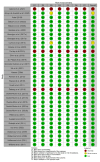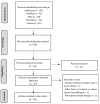Do Hormone Levels Influence Bullying during Childhood and Adolescence? A Systematic Review of the Literature
- PMID: 38397352
- PMCID: PMC10888185
- DOI: 10.3390/children11020241
Do Hormone Levels Influence Bullying during Childhood and Adolescence? A Systematic Review of the Literature
Abstract
(1) Background: Bullying is one of the most common forms of aggressive behavior during childhood and adolescence. Some decades ago, researchers began exploring the basis of peer victimization from a biological perspective. Specifically, the Hypothalamic-Pituitary-Adrenal (HPA) and Hypothalamic-Pituitary-Gonadal (HPG) axes have been studied in relation to status-relevant behaviors, such as bullying. (2) Methods: We conducted a systematic review following the PRISMA guide and registered the review protocol at PROSPERO (CRD42023494738). We searched for relevant studies in PubMed, Psycinfo, Scopus, and Web of Science, and assessed them using the Robins E-tool. (3) Results: Our search yielded 152 studies, of which 33 were included in the review. These studies explored the association between testosterone and cortisol levels with bullying behavior, finding diverse results. Most of the studies were rated as having a low risk of bias. (4) Conclusions: This study not only enhances our understanding of bullying, but also provides guidance for the development of prevention and management programs for it. In the future, researchers should continue exploring the joint effects of different hormones on the HPA and HPG axis, using a broader set of biomarkers.
Keywords: bullying; children and adolescents; cortisol; testosterone.
Conflict of interest statement
The authors declare no conflicts of interest.
Figures
References
-
- UNESCO . Más Allá de Los Números: Poner Fin a La Violencia y El Acoso En El Ámbito Escolar. UNESCO; Paris, France: 2021.
-
- Smith P.K. Bullying: Definition, Types, Causes, Consequences and Intervention. Soc. Personal. Psychol. Compass. 2016;9:519–532. doi: 10.1111/spc3.12266. - DOI
-
- Garaigordobil M., Oñederra J.A. La Violencia Entre Iguales. Revisión Teórica y Estrategias de Intervención. Pirámide; Madrid, Spain: 2010. Revisión Teórica Del Bullying: Concepto, Teorías y Prevalencia Del Fenómeno; pp. 29–178.
-
- García-García J., Ortega E., De la Fuente L., Zaldívar F., Gil-Fenoy M.J. Systematic Review of the Prevalence of School Violence in Spain. Procedia—Soc. Behav. Sci. 2017;237:125–129. doi: 10.1016/j.sbspro.2017.02.052. - DOI
Publication types
Grants and funding
LinkOut - more resources
Full Text Sources



